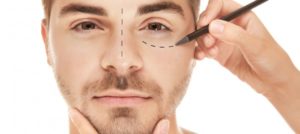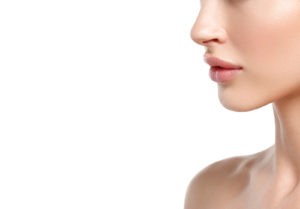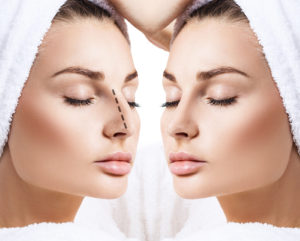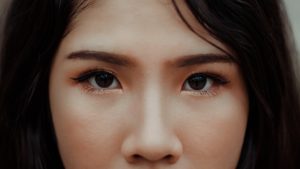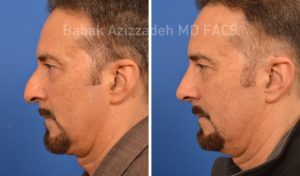About Revision Rhinoplasty
Patients Undergo Revision rhinoplasty surgery to reshape the nose and enhance his or her cosmetic appearance after a previous rhinoplasty procedure failed to deliver optimal results. Also, this facial plastic surgery can be used to restore the nasal function if it was impaired during a previous rhinoplasty.
Dr. Azizzadeh of the CENTER for Advanced Facial Plastic Surgery in Beverly Hills understands the intricacies of revision rhinoplasty surgery. This is one of the most complex facial plastic surgery procedures, one that must be completed by an experienced and knowledgeable facial plastic surgeon. Dr. Azizzadeh possesses extensive revision rhinoplasty expertise and will devote the necessary time and resources to help a patient accomplish his or her desired revision nose job goals. He will precisely correct the delicate structures of the nose during surgery, and as such, ensure a patient receives extensive support before, during and after the rhinoplasty surgery.
Revision Rhinoplasty Benefits
The benefits of revision rhinoplasty are similar to those associated with primary rhinoplasty surgery. Common benefits include:
- Rejuvenated Facial Appearance: Revision rhinoplasty is used to reshape the nose, resulting in a more youthful and balanced facial appearance.
- Improved Breathing: Revision rhinoplasty is sometimes performed in combination with nasal obstruction surgery or a septoplasty to correct nasal obstructions that occur due to a prior nose surgery.
- Enhanced Facial Symmetry: Revision rhinoplasty is used to correct a bulbous nasal tip, crooked nose, and other facial problems, leading to improved facial symmetry.
- Increased Self-Confidence: Revision rhinoplasty revitalizes the appearance and shape of the nose, and as such, often provides a confidence-booster for patients who are self-conscious about their facial appearance.
During an initial consultation, Dr. Azizzadeh teaches patients about how the surgery is performed, and its benefits. That way, Dr. Azizzadeh allocates time and resources to ensure patients understand all aspects of the procedure and can make informed treatment decisions.
How Does a Primary Rhinoplasty Differ from a Revision Rhinoplasty?
Primary rhinoplasty surgery is one of the most-popular facial plastic surgeries. It is used to reshape the nose to improve the facial aesthetic. Or, primary nose surgery is used to treat a deviated septum, breathing problems, or other structural defects of the nose and restore the nasal function.
Comparatively, revision rhinoplasty is performed after a primary nose surgery fails to deliver the desired results. A revision nose job is similar to a primary rhinoplasty because it is used to address the facial aesthetic or correct structural problems associated with the nose. However, a revision procedure is performed if an initial nose job does not help a patient achieve his or her treatment goals. Revision rhinoplasty often takes longer to perform than a traditional rhinoplasty procedure too.
A revision rhinoplasty procedure is performed after primary nose surgery. Revision rhinoplasty is also more complex and takes longer to perform than a primary nose job.
Dr. Azizzadeh consistently ranks as one of the top revision rhinoplasty surgeons in California, thanks in part to his commitment to patient education. He is happy to explain the similarities and differences between revision rhinoplasty and primary nose job surgery. In doing so, Dr. Azizzadeh helps patients determine whether a revision nose job can help them achieve their facial plastic surgery goals.
Searching for the Best Revision Rhinoplasty Surgeon in Los Angeles? Here's Why Patients Choose Dr. Azizzadeh
Dr. Azizzadeh is dual board-certified in facial plastic and reconstructive surgery and otolaryngology (head and neck surgery). He possesses in-depth knowledge of the underlying structures of the face and head that he applies to his revision rhinoplasty surgery techniques.
Am I a Candidate for Revision Rhinoplasty?
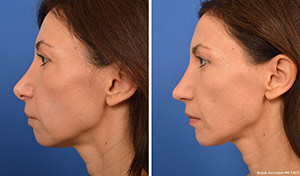 If a patient is unhappy with the cosmetic results of a nose job, revision rhinoplasty may provide a second chance to improve their facial appearance.
If a patient is unhappy with the cosmetic results of a nose job, revision rhinoplasty may provide a second chance to improve their facial appearance.
A primary rhinoplasty takes one to two years to fully heal. Dr. Azizzadeh knows it can be difficult to wait to see if a nose job delivers the desired results. He educates his patients on the importance of letting the nose heal before performing revision rhinoplasty surgery.
If revision rhinoplasty is performed, it can correct the following issues:
- Short nose
- Nasal hump
- Pinched nose deformity
- Breathing issues / difficulty
- Twisted nose
- Unnatural looking tip
- Visible scars
- Scooped bridge
- Nasal tip bossae (reverse rhinoplasty)
- Asymmetric nostrils
- Large nose
- Unbalanced nasal aesthetics
- Unbalanced chin aesthetics
If a patient’s nasal function was damaged during a primary rhinoplasty procedure, a revision nose job can be used to repair this issue.
What Should You Expect During a Consultation with a Revision Rhinoplasty Specialist?
Dr. Azizzadeh performs a comprehensive revision rhinoplasty consultation. He uses the meeting to learn about his patient and address their revision nose surgery concerns.
The consultation enables Dr. Azizzadeh to understand his patient’s revision rhinoplasty goals. Plus, Dr. Azizzadeh responds to his patient’s revision nose job questions. By the end of the consultation, Dr. Azizzadeh can determine if the patient is a good candidate for a revision nose job. Meanwhile, the patient can receive a personalized revision nose job recommendation and feel comfortable with treatment.
During the consultation process, Dr. Azizzadeh will evaluate his patient’s nasal bridge, nostrils, and tip of the nose. These factors are examined in conjunction with the patient’s cheeks, chin, eyebrows, forehead, and lips. This helps Dr. Azizzadeh find the best way to provide his patient with a natural-looking and functional nose.
Other factors that Dr. Azizzadeh examines during a consultation include:
- Upper portion of the nose (nasal bones)
- Middle portion of the nose (cartilaginous network)
- Tip of the nose (including nostrils)
- Functional components of the nose, such as the septum, turbinates and nasal valves
Dr. Azizzadeh recommends a patient bring their medical records to a consultation. This information enables Dr. Azizzadeh to review his patient’s medical history and offer an appropriate treatment recommendation.
How Does Dr. Azizzadeh Use 3D Imaging During the Consultation Process?
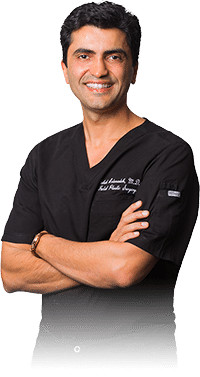 The Vectra 3D imaging system allows Dr. Azizzadeh to take 3D photographs of a patient’s face and use these images to understand how an individual will look before and after revision rhinoplasty.
The Vectra 3D imaging system allows Dr. Azizzadeh to take 3D photographs of a patient’s face and use these images to understand how an individual will look before and after revision rhinoplasty.
With the Vectra system, Dr. Azizzadeh can capture all angles of an individual’s face. Then, he can display images that highlight the expected outcome of revision rhinoplasty, so that a patient can see how the procedure will impact his or her facial appearance.
Dr. Azzizadeh’s Approach to Revision Rhinoplasty
Dr. Azizzadeh takes a detailed approach to revision rhinoplasty. He believes there is no such thing as a “standard” revision nose surgery. Dr. Azizzadeh carefully takes note of each issue in a patient’s nose and its impact on the patient’s facial appearance.
Also, Dr. Azizzadeh takes pride in providing his patients with honest and realistic expectations for revision rhinoplasty. As a leading expert in the area, Dr. Azizzadeh has worked with many patients who were initially promised unrealistic results during primary rhinoplasty procedures.
Dr. Azizzadeh builds trust with his revision rhinoplasty patients. He has his patients’ best interests in mind. As such, Dr. Azizzadeh is upfront with his patients and sets realistic expectations for revision nose surgery procedures.
What Is a Natural-Looking Revision Rhinoplasty?
Dr. Azizzadeh thoroughly examines a revision rhinoplasty patient’s bone structure, lips, chin, neck, and under-eye area. He wants these facial components to look proportional to the nose.
Ultimately, Dr. Azizzadeh wants his patient’s eyes to be the focus of their face. When someone looks at a patient and their focus naturally goes to their eyes, that is the natural result of a revision rhinoplasty procedure. The key aspect: the nose creates the perfect balance between all of the patient’s facial features.
How to Prepare for Revision Rhinoplasty Surgery
Dr. Azizzadeh provides instructions to help a revision rhinoplasty patient prepare for treatment. He explains what a patient should do the night before and morning of a revision rhinoplasty. Dr. Azizzadeh also offers postoperative revision rhinoplasty care instructions.
Some medications may cause a revision rhinoplasty patient to bleed more than normal during treatment. Therefore, Dr. Azizzadeh may recommend revision rhinoplasty patients stop taking certain medications for at least a few weeks before surgery.
Revision Rhinoplasty Recovery
Dr. Azizzadeh provides revision rhinoplasty recovery guidelines, including:
- Clean surgical incisions with hydrogen peroxide once a day and use antibiotic salves on the incisions twice a day.
- Use cold compresses for the first three days following surgery; then, switch to a warm compress on bruises.
- Keep the head elevated for at least one week following surgery. This includes any time a patient sleeps, rests, or relaxes.
- Patients can exercise and perform other strenuous activities three to four weeks after surgery. They should receive clearance from Dr. Azizzadeh before resuming any strenuous activities.
At the CENTER, Dr. Azizzadeh wants his revision rhinoplasty patients to enjoy a smooth recovery period. If any questions or concerns arise during revision rhinoplasty recovery, Dr. Azizzadeh can respond to them.
What Happens During the Revision Rhinoplasty Recovery Period?
The revision rhinoplasty recovery period lasts one to two weeks. A patient may need to stay home from work for seven to 10 days after surgery, depending on the amount of bruising and swelling. The patient will have a splint on their nose, which will be removed one week after treatment. Most patients will not have nasal packing after a revision rhinoplasty.
Revision rhinoplasty requires a long-term commitment and routine follow-ups. Full results will appear within one to two years after surgery once all internal swelling has dissipated. Dr. Azizzadeh will continue to consult with a patient to ensure their progress remains on track. He asks to see patients every three months for the first year and annually after that.
Why Do Patients Choose Dr. Azizzadeh for Revision Rhinoplasty in Los Angeles?
Dr. Azizzadeh understands the challenges associated with traditional and revision rhinoplasty procedures. Yet, Dr. Azizzadeh’s goal is the same for all rhinoplasty procedures: to ensure a patient can enjoy a functional nose and a balanced, natural-looking facial appearance. To accomplish this goal, Dr. Azizzadeh creates a custom revision rhinoplasty treatment plan for each patient. Next, Dr. Azizzadeh executes this plan and helps his patient achieve the full results of revision rhinoplasty surgery.
FAQs About Revision Rhinoplasty
Revision rhinoplasty helps an individual correct the results of a bad nose job. It may be performed for cosmetic or medical reasons, and studies indicate revision rhinoplasty is performed after approximately 5 percent to 15 percent of nose jobs.
Dr. Azizzadeh tailors a revision nose job to his patient and offers comprehensive assistance following surgery. He cannot guarantee the results of a revision rhinoplasty or any other surgery. But, Dr. Azizzadeh’s approach to revision nose job surgery minimizes risk and boosts the likelihood of successful treatment results.
Common reasons to pursue revision rhinoplasty surgery include:
- An initial rhinoplasty does not deliver the desired results
- Too much cartilage is removed during a nose job
- Cartilage on the inside of a patient’s nose is bent or swollen following a nose surgery
- Polyps form inside of a rhinoplasty patient’s nose form that interfere with his or her airflow
- A patient’s nose was injured or damaged during a nose surgery
- A patient’s nose did not heal correctly following a nose surgery
Revision rhinoplasty may be ideal for individuals who are dealing with cosmetic or functional issues after nose surgery. In some instances, patients request revision rhinoplasty to create facial harmony following a failed nose job. Or, in other instances, patients undergo revision rhinoplasty surgery to treat functional nasal issues that occur after a nose job.
Dr. Azizzadeh does not generally recommend nose surgery until an individual’s nose has fully grown. This typically occurs as early as 15 or 16 years old for girls and 16 or 17 years old for boys.
To determine if an individual is eligible for revision rhinoplasty surgery, Dr. Azizzadeh meets with him or her and performs an evaluation. If Dr. Azizzadeh believes a secondary nose surgery can help a patient correct mistakes from a past nose job, he will perform a revision rhinoplasty.
Some of the most common reasons why nose jobs fail include:
- Poor planning prior to treatment
- Subpar incision placement
- Excessive removal of cartilage and bone from the nasal bridge
- Nasal tip cartilage damage
- Inadequate or unnecessary use of skin grafts
- Excessive removal of septal cartilage
Dr. Azizzadeh understands there are many reasons why a primary rhinoplasty fails to deliver the intended results. He can help patients determine if they qualify for a rhinoplasty tip revision procedure or other facial rejuvenation treatment options.
There is a low risk of complications associated with revision rhinoplasty. Common revision nose surgery complications include:
- Bleeding
- Adverse reaction to anesthesia
- Nasal blockage
- Infection
- Temporary loss of sense of smell
- Scarring
- Skin loss
Dr. Azizzadeh strives to help a patient make an informed treatment decision. As such, he educates patients about revision rhinoplasty, its benefits and its potential complications prior to treatment. Dr. Azizzadeh also crafts a custom treatment plan designed to help a patient minimize the risk of complications. With this plan in place, Dr. Azizzadeh and a patient can work together to achieve the optimal revision nose surgery results.
Revision rhinoplasty is a highly specialized procedure. Therefore, it is important to work with a facial plastic and reconstructive surgeon who possesses extensive knowledge of the nose, face and head.
Dr. Azizzadeh has dual certification in head and neck surgery and facial plastic and reconstructive surgery. He takes a holistic approach to revision rhinoplasty procedures, and by doing so, helps patients address both cosmetic and functional nasal problems.
Revision rhinoplasty is typically performed under general anesthesia.
Revision rhinoplasty and septoplasty procedures are both nose surgeries, but there are many differences between the two. A revision rhinoplasty corrects the results of a prior nose job. On the other hand, a septoplasty treats a deviated septum, a problem that occurs when the bone and cartilage between the nostrils are displaced. During a septoplasty, the nasal septum is repositioned and straightened.
The cost of a revision rhinoplasty surgery varies based on the surgeon performing the procedure, the extent of the surgery needed and other factors. Dr. Azizzadeh explains the costs associated with revision rhinoplasty before he performs the procedure.
A revision nose job tends to be more expensive than a primary rhinoplasty. This is due to the fact that a revision nose job can require additional time and resources to complete in comparison to a primary nose surgery.
A revision rhinoplasty procedure is not covered by insurance if it is performed for cosmetic reasons. If a revision rhinoplasty is required due to a broken nose or other nose trauma that occurred after a primary nose job, a patient’s insurer may cover a portion or all of the cost of treatment.
For patients who do not receive insurance coverage for a revision rhinoplasty, financing options are available. Dr. Azizzadeh can discuss financing for a revision rhinoplasty during a patient consultation.
For those who break their nose after undergoing rhinoplasty surgery, there is no guarantee they will need a revision rhinoplasty. Each person’s nose is different, and trauma affects the nose in different ways. If a person experiences severe trauma due to a broken nose, he or she may require a rhinoplasty or revision rhinoplasty to address this issue.
The ultimate goal of a rhinoplasty is to help a patient achieve a balanced, natural-looking facial appearance, with a nose that complements the eyes, cheeks and other facial features. Meanwhile, a bad nose job results in an unbalanced or unnatural-looking facial appearance defined by any of the following facial characteristics:
- Low nasal bridge
- Upturned nose
- Pinched nose
- Nasal tip appears as wide as the nasal bridge
- Nostrils look too wide or too large
If a person undergoes a rhinoplasty surgery but experiences any of the aforementioned issues, consulting with Dr. Azizzadeh is key. Dr. Azizzadeh works closely with a patient to address problems caused by a previous rhinoplasty. He develops a personalized revision rhinoplasty treatment plan for each of his patients. Dr. Azizzadeh also monitors his patient’s progress after a revision rhinoplasty surgery to ensure his patient achieves the best results.
A rhinoplasty is tailored to a patient, and each patient heals at his or her own pace. Thus, the time required after rhinoplasty surgery before a patient can get a revision rhinoplasty varies.
Most surgeons recommend patients wait at least one year after rhinoplasty surgery, before they undergo a revision rhinoplasty.
Dr. Azizzadeh is happy to meet with a patient who is considering revision rhinoplasty surgery. He evaluates each patient to determine if now is a good time for a revision rhinoplasty procedure. If Dr. Azizzadeh believes revision rhinoplasty surgery can be safely performed, he offers a personalized treatment recommendation. Or, if Dr. Azizzadeh believes revision rhinoplasty is too risky, he may recommend waiting to perform the procedure at a later date.
Revision rhinoplasty is customized to a patient. During a revision rhinoplasty procedure, a patient first receives general anesthesia. Next, Dr. Azizzadeh makes incisions and separates the skin of the nose from underlying bone and cartilage. At this point, Dr. Azizzadeh may reposition cartilage and replace missing nasal structures in the nose to improve the form and function of the nose. Finally, Dr. Azizzadeh pulls the skin back down and closes the incisions.
Revision rhinoplasty surgery usually requires between one and two hours to complete. Before a revision rhinoplasty, Dr. Azizzadeh outlines all treatment stages. This helps a patient establish realistic expectations and plan accordingly based on the estimated time required to complete a revision rhinoplasty procedure.
The recovery process for revision and primary rhinoplasties can be similar, but a patient may require additional time to recover after a revision nose job in comparison to a primary rhinoplasty. A patient may also experience swelling and bruising that lasts longer following a revision rhinoplasty in contrast to a primary nose job.
To recover from a revision rhinoplasty as quickly as possible, a patient should follow all post-surgery instructions from Dr. Azizzadeh. If a patient has concerns or questions about post-revision rhinoplasty surgery instructions, it is crucial to reach out to Dr. Azizzadeh for immediate support.
If Dr. Azizzadeh performs a closed revision nose surgery, the incisions are confined to the nose. In this instance, no visible scarring will appear following surgery.
Comparatively, if Dr. Azizzadeh conducts an open revision rhinoplasty procedure, minimal scarring may occur. During this procedure, Dr. Azizzadeh makes a small incision under the tip of the nose. This may result in a small scar that is virtually invisible.
Dr. Azizzadeh performs a full patient evaluation prior to a revision rhinoplasty procedure. He then recommends an open or closed procedure based on the patient, his or her treatment goals and other factors.
Additionally, Dr. Azizzadeh does everything possible to minimize the risk of revision rhinoplasty complications. He works diligently to make precise incisions and ensure each patient receives the best care. As such, Dr. Azizzadeh helps limit the risk of scarring and other revision rhinoplasty surgery complications.
The surgery itself is not painful because the patient is under anesthesia. After surgery, patients are prescribed pain medications so they are comfortable during their recovery.
Dr. Azizzadeh does not allow a patient to drive himself or herself home after a revision rhinoplasty procedure. Instead, a patient will need to find someone who can drive him or her home following surgery.
Stitches are generally removed within about six to eight days of treatment. Stitches are usually absorbed by the skin. Therefore, Dr. Azizzadeh may trim the stitches, which will not result in any pain.
There are no guarantees with any facial rejuvenation procedure. However, Dr. Azizzadeh keeps the lines of communication open with his patients. During a consultation, Dr. Azizzadeh outlines the benefits and risks of revision rhinoplasty. Dr. Azizzadeh also helps each patient weigh the pros and cons of a revision rhinoplasty procedure. In doing so, Dr. Azizzadeh helps each of his patients make an informed decision about revision rhinoplasty.
The final results of a revision rhinoplasty procedure can take up to two years to become visible. In the meantime, Dr. Azizzadeh requests follow-up appointments to evaluate his patient’s progress.
Dr. Azizzadeh monitors his patient’s progress closely during the recovery period. He is also available to respond to a revision rhinoplasty patient’s questions after surgery.
In the event that a patient experiences revision rhinoplasty complications, notify Dr. Azizzadeh. Then, Dr. Azizzadeh can meet with a patient to correct any issues that otherwise hamper revision rhinoplasty recovery. If a patient experiences breathing problems or other revision rhinoplasty complications that can be life-threatening, call 911.
Are You Considering Revision Rhinoplasty in Los Angeles? Schedule a Treatment Consultation with Dr. Azizzadeh

For those who are not satisfied with the results of a primary rhinoplasty, Dr. Azizzadeh can help. Dr. Azizzadeh is an internationally acclaimed facial plastic and reconstructive surgeon who has performed many successful revision rhinoplasty procedures in California. He helps revision rhinoplasty patients address nasal deformities, breathing difficulties and other problems caused by previous nose surgeries. Dr. Azizzadeh also customizes each revision rhinoplasty to his patient, enabling an individual to achieve a nose that perfectly complements his or her facial features.
Dr. Azizzadeh is available to teach individuals about revision rhinoplasty. To learn more about revision rhinoplasty, please schedule a consultation with Dr. Azizzadeh at the CENTER for Advanced Facial Plastic Surgery in Beverly Hills or call 310-657-2203.

